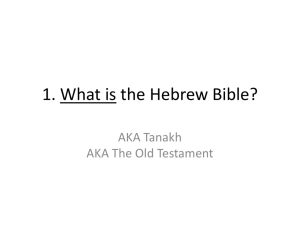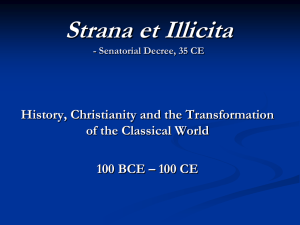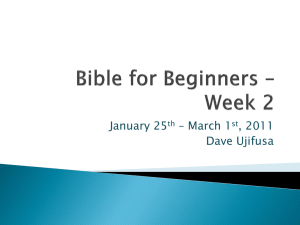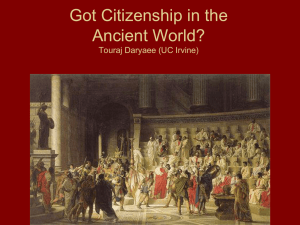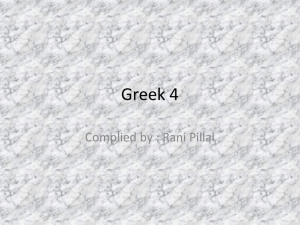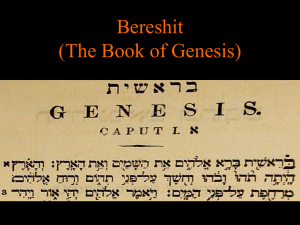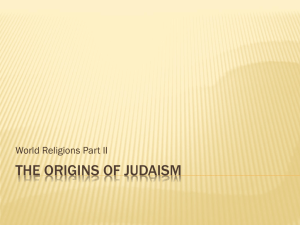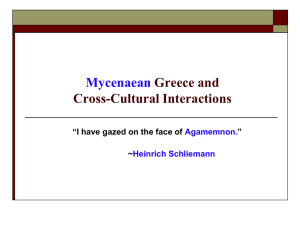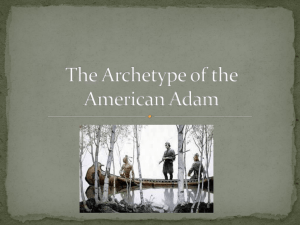Revision of Weeks 11 _ 14
advertisement
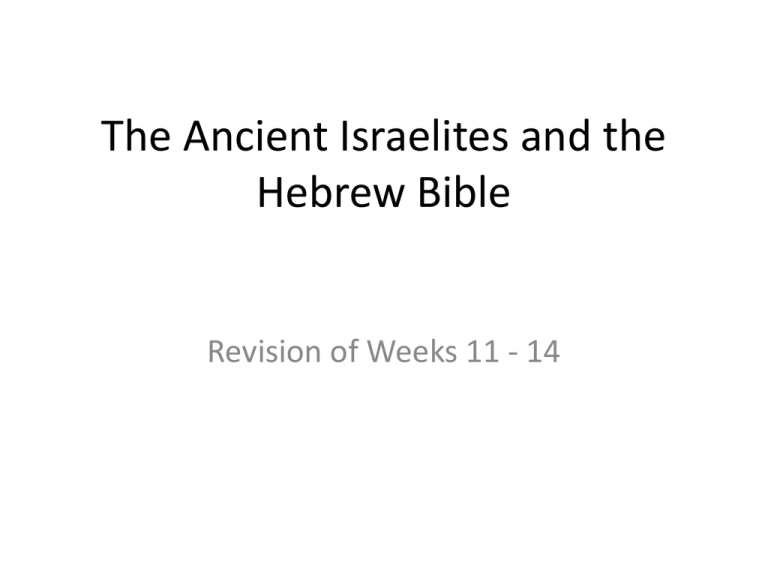
The Ancient Israelites and the Hebrew Bible Revision of Weeks 11 - 14 Who are the Jews? • AKA Hebrews, AKA Israelites • (One of the) first monotheistic religions = worship of one God. • Their history, beliefs and laws are recorded in the Tanakh and the Talmud. 1. What is the Hebrew Bible? AKA Tanakh AKA The Old Testament The Holy Book of Judaism • The Tanakh is the chief holy book of Judaism • Judaism’s other holy book is called the Talmud. • The Talmud is largely composed of an oral tradition of interpretation of the the Tanakh that was eventually written down. The Hebrew Bible is also part of the Christian Bible • The Hebrew Bible is the first part of the Christian Bible – what is called the Old Testament. • Jesus was a Jew, as were the first Christians. • At first Christianity was a new development within Judaism, only after time did it become a separate religion. Stories of the Hebrew Bible also retold in Islam’s holy book – the Quran The Structure of the Bible • The Hebrew Bible aka the Old Testament (Christian & Jewish): The Law – The five books of Moses The Prophets – history of the united monarchy and the kingdoms of Judah and Israel, including Joshua, Judges, Samuel and Kings. The Writings New Testament (Christian): Gospels - the life and death of Jesus Acts of the Apostles - the work and teaching of the early founders of the Church Epistles - letters from Christian leaders, particularly Paul, to Christian communities Book of Revelation TaNaK (Tanakh) aka the Hebrew Bible, aka Old Testament • An acronym for the three parts of the text: Torah (law); Nebi’im (prophets); Kethub’im (writings) • A total of 24 books (39 by the Christian system of counting) Torah (also called Books of Moses or Pentateuch) • • • • • Genesis Exodus Leviticus Numbers Deuteronomy The Torah as a Collection • First part of the canon established • It was pulled together after the fall of Jerusalem in 587/86 BCE. • Regarded as fixed by the 4th century BCE • Most authoritative texts in Judaism The origins of the Torah according to the Torah • According to biblical tradition, the Torah was revealed to Moses at Sinai. • Aron Tendler, Associate Rabbi, Yeshiva University: “We believe the Torah was written by the hand of Moses but dictated to him by God himself in a totally divine manner, no different than you would dictate a letter to a secretary.” Prophets (Nebi’im or Nevi’im) • Former Prophets – – – – Joshua Judges Samuel Kings • Latter Prophets – Major Prophets • Isaiah • Jeremiah • Ezekiel – Minor Prophets (Book of the 12) • Hosea, Joel, Amos, Obadiah, Jonah, Micah, Nahum, Habakkuk, Zephaniah, Haggai, Zechariah, Malachi Writings (Kethub’im or Kethuv’im) • • • • • • Psalms Proverbs Job Song of Songs Ruth Lamentations • • • • • Ecclesiastes Esther Daniel Ezra-Nehemiah Chronicles The Tanakh • The Tanakh is written primarily in Hebrew • We do not have any original manuscripts; we only have copies of copies • Codex Leningradensis is the oldest complete Hebrew manuscript we have. It dates to 1008 CE Genesis Chapters 1 - 3 The Documentary Hypothesis • The Documentary Hypothesis is the theory that the first five books of the Hebrew Bible (aka The Torah aka The Five Books of Moses aka the Pentateuch) derive from four distinct sources. These four sources sometimes overlap and are sometimes inconsistent. When did God create woman? When did God create woman? • Chapter 1: 27 So God created mankind in his own image, in the image of God he created them; male and female he created them. Chapter 2: God creates Adam. At first he is alone. Almost as if the creation recounted in chapter 1 had never happened. Then creates all the animals and has Adam name them and only then creates Eve. When did God create birds? When did God create birds? • [On the 5th day, prior to creation of man and woman on the 6th day] 20 And God said, “Let the water teem with living creatures, and let birds fly above the earth across the vault of the sky.” 21 So God created the great creatures of the sea and every living thing with which the water teems and that moves about in it, according to their kinds, and every winged bird according to its kind.” [Man and woman created on the 6th day]. • Gen 2:19 Animals and birds created after Adam, in conflict with chapter 1. When did God create plants? When did God create plants? • Gen 2:4-7 seems to announce a wholly new beginning. Seems to say humanity was created before plant life but Chapter 1 has vegetation created on the third day (along with the earth) and humanity created on the sixth. What is God like? What is God like? • Chapter 1: God is a cosmic sovereign. • Chapters 2 and 3: God is a divine craftsman. He Himself shapes Adam out of the mud and breathes air into his nostrils. God walks about the Garden (Gen 3:8). When Adam and Eve hide from him, he calls out “where are you?” Apparently, he does not know. At the end, God makes clothes for the pair – another hands-on act. ‘God’ vs ‘Lord God’ • God is referred to quite consistently in chapter 1 by the word “God” (elohim). • Starting at Gen 2:4, exactly where the story of Adam and Eve begins, he suddenly becomes “the Lord God”. The word “God” is now preceded by YHWH (the proper name of the Hebrew god). “The Lord God” is used consistently until the end of chapter 3. • The writer who referred to him as God saw him as a cosmic deity. • The writer who used the name “the Lord God” conceived of him in more personal terms, a sort of divine humanoid who walked around and shaped things and made clothes. The Documentary Hypothesis The Yawehist (J) is the source of the Adam and Eve story The Yawehist (J) is the source of the Adam and Eve story • Story of Adam and Eve a product of the author known as J: uses YHWH; anthropomorphic conception of God; focused on humanity; the effect of past events on humanity’s present condition • People have to work for food, women have to suffer the pain of childbirth because of the first humans’ disobedience. • Human beings are called man (adam in Hebrew) because that’s what the first created human was called. This in turn was because he was made out of the ground (adamah) Adam and Eve as allegory Adam and Eve as allegory • Interesting theory about the meaning of Adam and Eve – seems to reflect the moment humanity discovered the secret of agriculture. Figuring out that seeds can be collected and then deliberately planted in fields was a great step forward for humanity. But agriculture brought with it certain pains – working long hours under the sun, earning one’s bread “by the sweat of your face” (Gen 3:19) Adam and Eve as allegory • At a similar stage of historical development, people began to wear more clothes. • At a similar time, human beings discovered that childbirth is the result of an “act of planting” nine months earlier. Before this discovery, a father may not understand he has any specific relationship to this or that child. Afterwards, the man “will cling to his wife and they shall be one flesh” (Gen 2: 24). Noah and the Flood What doublets occur in Genesis, Chapters 6 – 9? Noah and the Flood Q) What similarities exist between the Mesopotamian and biblical flood stories? Quote from The Epic of Gilgamesh Similarity with the Biblical flood story The hearts of the Great Gods moved them to inflict the Flood. Gods decide to send a flood. Tear down the house and build a boat! Command to build a boat. ... keep alive living beings! Make all living beings go up into the boat. Instruction to take other living beings onto the boat/ark. The boat which you are to build, its dimensions must measure equal to each other: its length must correspond to its width. The dimensions of the boat are specified. Roof it over like the Apsu. Roofed over like the ark three times 3,600 (units of) pitch ...into it Common building material I had all my kith and kin go up into the boat, Family enters the ark I went into the boat and sealed the entry. Similar to Noah’s entry onto the ark submerging the mountain in water Mountains submerged with water On Mt. Nimush the boat lodged firm Boat comes to rest on a mountain I sent forth a dove and released it. The dove went off, but came back to me... Similar to Noah sending out birds to see if the water has receded Then I sent out everything in all directions and sacrificed (a sheep). Sacrifice offered to the Gods The gods smelled the savor Gods smell the sacrifice Abraham (Genesis) 1813 BCE: Abraham born 1738 BCE: Abraham settles in Canaan 1677 BCE: Isaac prepared as sacrifice 1653 BCE: Jacob born Watson - No independent corroboration for any of the early figures (although Egyptian and Babylonian kings at the time of, say, Moses are firmly established, we know of their actions, remains have been found) - - No archaeological evidence that Abraham, Noah, Moses or Joshua ever existed - - Place names, Philistines, domesticated camels all belong to 1200 BC and after - - Inconsistency between two accounts of creation in Genesis Abraham (Genesis) Kugel 1813 BCE: Abraham born 1738 BCE: Abraham settles in Canaan 1677 BCE: Isaac prepared as sacrifice 1653 BCE: Jacob born - 19th Century scholarship: “… believed that someone (that is, J or E) who lived long after Abraham, indeed, long after the people of Israel had settled Canaan, made up these stories in order to justify that settlement…” - 2Oth Century – first half: discovery of Ur (which had disappeared from history in the 17th century BCE); Nuzi tablets (near Haran) reveal legal practices, customs that fit with Abraham narrative; Mari tablets mention names that are those of Abraham’s family. His life and times appear to fit uniquely well with the first half of the 2nd millennium BCE. - 20th Century – second half: Philistines interacting with Abraham seems anachronistic; absence of any reference to Abraham of Israel’s 8th and 7th century prophets; one scholar argues Abraham’s story created to reflect the Jews’ return after exile in Babylon; nowhere in the bible does it say that Abraham did not worship other Gods. - Sacrifice a ritual to mark an agreement like a signature is today Joseph (Genesis) Kugel 1562 BCE: Joseph born 1546 BCE: Joseph sold into slavery 1532 BCE: Joseph becomes Egypt's viceroy 1523 BCE: Jacob and family move to Egypt - “Ancient Egyptian records reveal that Semitic peoples from the area of Canaan did indeed frequently go down to Egypt in time of famine...” - Western Semites known as the Hyksos, actually took over control of Egypt for a century or so (approximately 1670 – 1570 BCE) Moses (Exodus) 1429 BCE: Egyptian enslavement begins 1393 BCE: Moses born 1313 BCE: Exodus from Egypt Revelation at Mt Sinai 1312 BCE: Moses brings down second set of tablets Watson - No independent corroboration for any of the early figures (although Egyptian and Babylonian kings at the time of, say, Moses are firmly established) - - “One account has the descendants of Abraham going to Egypt and then being led by Moses, via the Wilderness, into Canaan. In the other account, the land is settled from the east, with no mention of Egypt.” (Watson, p. 156) - - “It is the J source that refers to the special relationship between God and the Jews, but there is no mention of a covenant concerning the land. This is why the covenant is thought to be a later invention of the 6th century when, during exile, the Jews became aware of Zoroastrian beliefs in Babylon.” Kugel - Expulsion of the Hyksos may be the basis for the Exodus story Is the Bible’s story of the conquest of Canaan accurate? Jericho and other archaeological evidence Joshua and the conquest of Canaan 1272 BCE: Death of Moses Yehoshua (Joshua) leads Jews into Israel Watson - Menetaph stele dated to 1204 BC records Egyptian conquest of Ashkelon and Gezer and describes the destruction of ‘the people of Israel’. - No independent corroboration for any of the early figures (although Egyptian and Babylonian kings at the time of, say, Moses are firmly established) - No archaeological evidence to support the story of a 13th century conquest followed by a united monarchy - no evidence of a short military campaign of conquest - no evidence of any cities in the area being sacked or burned - Arud, Ai and Gibeon – said to have been conquered by Joshua are now known not to have existed then - Evidence of continuity of lifestyle: distinctive pottery, fourroom house evolved over 150 years Merneptah Stele (aka the Menetaph Stele, aka Israel Stele) Merneptah Stele • Dated to 1209/1208 BCE • Inscription by the Ancient Egyptian king Merneptah (reign:1213 to 1203 BC) • Found at Thebes Merneptah Stele • “Canaan is captive with all woe. Ashkelon is conquered, Gezer seized, Yanoam made nonexistent; Israel is wasted, bare of seed.” Merneptah Stele • The determinative accompanying Gezer, Ashkelon and Yanoam indicate they are citystates. • The determinative accompanying Israel indicates it is a foreign people, perhaps a nomadic tribe. Merneptah Stele • Scholarly debate about translation for I.si.ri.ar. Some scholars suggest it doesn’t refer to Israel but Jezreel. • Only known Egyptian reference to the Israelites • Earliest known reference to the Israelites Alt’s theory of settlement El Amarna Letters Canaanite Exurbanite Model
